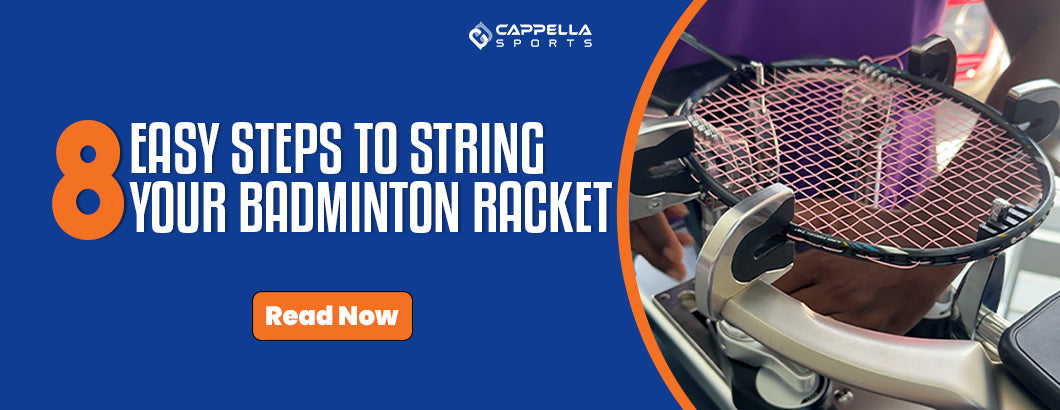If you’re passionate about badminton, you already know that your racket is not just a piece of equipment - it's an extension of your skill. But no matter how great your racket is, the strings won’t last forever. With regular play, the strings undergo wear and tear, and eventually, they snap. This is especially true if you're someone who plays often or enjoys high-intensity smashes and rallies.
Even rackets that come pre-strung will need a restring after consistent use. Stringing isn’t just about fixing broken strings - it’s about keeping your game sharp, responsive, and powerful.
In this detailed guide, we’ll walk you through everything you need to know to restring your badminton racket.
Why Restringing Requires Careful Attention
Restringing a badminton racket isn’t just about threading new strings through holes. It’s a technical process that involves choosing the right string type, diameter, tension, and stringing pattern - all of which impact your racket’s performance on court.
Let's break down the key factors that matter before you start the stringing process.
1. Understanding String Diameter
Badminton strings come in different thicknesses, commonly measured in millimeters. The diameter you choose significantly influences your gameplay and string durability:
Thicker strings (0.70mm and above):
-
These are stronger and last longer.
-
They produce a muted sound and deliver less power.
-
Ideal for players who want durability over explosiveness.
Thinner strings (0.66mm and below):
-
These offer superior performance with sharp, crisp hits.
-
Great for aggressive players who love smashes.
-
However, they are more prone to breakage and may need to be replaced frequently, which can be more expensive over time.
Choosing the right string thickness depends on your play style - control vs. power - and how often you’re willing to restring.
2. Getting the Right String Tension
String tension is measured in lbs and refers to how tightly the strings are pulled during stringing. The tension level directly affects control, power, and comfort:
Higher tension (28 - 30+ lbs):
-
Offers better control and accuracy.
-
Suitable for advanced players who generate their own power.
-
Requires more skill to handle and can stress the racket frame.
Lower tension (18 - 26 lbs):
-
Provides a larger sweet spot and more repulsion (power).
-
Easier on the arm, ideal for beginners and intermediates.
With modern rackets, many frames can withstand up to 30 lbs or more - but it’s crucial to check your racket’s recommended tension range to avoid damage.
Essential Tools for Stringing a Badminton Racket
To start stringing your racket, you’ll need a few specific tools and accessories:
-
High-quality strings (based on your preference for power, control, or durability)
-
A stringing machine
-
Your badminton racket (free from cracks or damage)
-
Clippers or string cutters
-
An awl (to clear blocked grommet holes)
-
Pliers (for tightening knots)
-
A ruler or measuring tape (to measure string length)
How to String a Badminton Racket – Step-by-Step
Once you have the tools ready and a clear understanding of the string and tension preferences, here’s how you can go about the stringing process:
Step 1: Measure the String
Based on your racket’s design and stringing pattern, measure an appropriate length of string.
Step 2: Straighten the String
Unwind and straighten the string to remove kinks or bends. This will help ensure a smoother stringing experience and better tension consistency.
Step 3: Prepare the Racket
Remove the old strings completely and inspect the grommets (string holes). Use the awl to unblock any blocked or deformed holes.
Step 4: Set the Stringing Machine
Calibrate the stringing machine to your desired tension. Double-check that the machine is clamped properly and stable.
Step 5: Mount the Racket
Secure the racket in the machine so that it doesn’t move during stringing. Identify the starting hole - typically near the middle of the racket head.
Step 6: Install the Main Strings
Start with the vertical (main) strings. Feed the string from one side of the frame through to the opposite hole. Continue this process for all the main strings, maintaining even tension throughout. Tie off one end and let the machine tension the other as you go.
Step 7: Tie the Knots
Once the main strings are installed, tie secure finishing knots. Ensure the racket is clamped so that tension doesn’t drop during this process.
Step 8: Install the Cross Strings
Now move on to the horizontal (cross) strings. Weave them over and under the main strings in a crisscross pattern. This ensures proper grip and string balance. Finish by tying the final knot.
Step 9: Unclamp the Racket
Once all strings are installed and tied, slowly release the clamps and remove the racket from the machine.
Stringing a badminton racket may seem complex at first, but with a bit of practice and the right tools, it becomes a valuable skill for any professional player. It gives you the freedom to fine-tune your racket exactly the way you like - whether you prioritize durability, control, or smashing power.
And remember: restringing your racket at the right time can be the difference between winning that tight game or missing your shot by inches. Keep your strings in top shape, and your racket will reward you every time you step onto the court.

